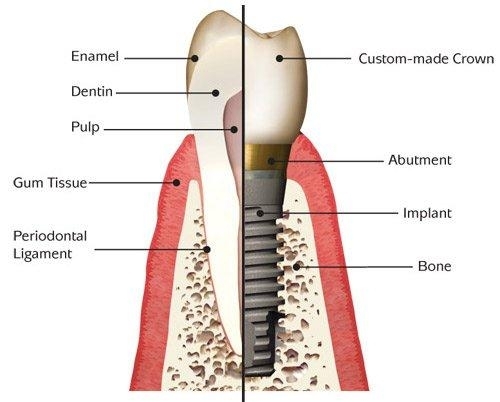Advanced Procedures
Implants
A dental implant is an option to replace a missing tooth. In this procedure, a small titanium shaft is surgically implanted into the bone and allowed to set. The bones grows around it forming a tight connection, which additionally slows or stops the bone loss that occurs when the root of a natural tooth is missing. Once the implant is firmly set in the mouth, the dentist then works to attach the replacement tooth onto the top of the shaft. This permanent solution has the advantages over bridge work that does not stress the surrounding teeth for support, and, should the tooth wear out, another can simply be replaced on the shaft.

Implants can also be used as support as part of an implant bridge. This is an alternative to partial dentures, and has several advantages. First, there is no adjustment period after the work is done as the patient only feels teeth, not metal supports intruding into the mouth. Second, this slows bone loss which is caused by missing teeth. Third, once work is done, there is no discomfort or difficulty in eating. And, best of all, implant bridges don't have to be taken in and out.
Additional
Implant Information can be found at Webmd.com.
Root Canal Treatment
Root canal treatment, also referred to as root canal therapy or endodontic therapy, is made necessary when a cavity is allowed to reach all the way to the nerve. (Regular cleanings and checkups can prevent and detect problems early.) In addition, deep restorations or trauma to a tooth may cause the nerve to be damaged to the point it needs root canal therapy. Once this occurs the pulp becomes infected, and can even extend through the root tip and being to eat away at the surrounding bone (this is an abscess). By the time the pulp is infected it must be treated, and cannot heal on its own. Infections of this extent can even weaken the entire immune system. This is dangerous, not to mention very painful. Symptoms that the pulp has become infected may include sensitivity to hot/cold or sweets, pain, swelling, pain to biting or pressure and a bad taste in the mouth. Sometimes, however, no symptoms are apparent and the person is unaware of any problem until a check up.
A root canal is then performed to clean out the infected tooth pulp, and disinfect the canals of the tooth. The only other treatment would be to extract the tooth. Once the infection is resolved, the canal(s) are filled in to prevent any further infection. Usually a core build-up and crown is recommended for restoring a tooth that has had root canal therapy.
Additional
Root Canal Information can be found at Webmd.com.
TMJ Treatments
TMJ stands for temporal-mandibular joint. Temporal, as in temple area of skull; mandibular as in mandible, or lower jaw; joint as in it's where the head and jaw meet. Problems in this joint may be caused by a misalignment of the teeth, trauma, or excess muscle tension. Aside from the two bones that meet there, cartilage buffers them and five muscles are involved in that area. If something goes wrong a good deal of trouble can result.
Problems in this area can cause:
-
Headaches
-
Earaches
-
Trouble/soreness in opening and closing the mouth
-
Clicking or popping of the jaw
-
Pain in the jaw muscles
-
Soreness in the area, sometimes extending to the face
Dental treatments for the condition can include replacing missing teeth, moving teeth, adjusting the bite, filling gaps between teeth, etc. There is no one solution that is right for all cases. Sometimes a plastic mouth piece is used to prevent clenching or grinding that is contributing to the problem. If untreated and taken to extremes, surgery may be required to repair a badly damaged joint.